| 1 |
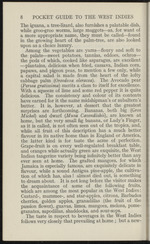 |
“...is made from the heart of the lofty
cabbage palm (Oreodoxa oleracea). The Avocado pear
(Persea gratissima) merits a class to itself for excellence.
With a squeeze of lime and some red pepper it is quite
delicious. The consistency and colour of its contents
have earned for it the name midshipman’s or subaltern’s
butter. It is, however, at dessert that the greatest
surprises are forthcoming. Bananas, both big (Gros
Michel) and dwarf (Musa Cavendishii), are known at
home, but the very small fig banana, or Lady’s Finger,
as it is called, is not often seen out of the tropics, and,
while all fruit of this description has a much better
flavour in its native home tiran in England or America,
the latter kind is for taste the acme of perfection.
Grape-fruit is on every well-regulated breakfast table,
and oranges while actually green are exquisite, the West
Indian tangerine variety being infinitely better than any
ever seen at home. The grafted mangoes, for which
Jamaica is especially famous, are...”
|
|
| 2 |
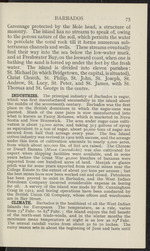 |
“...what is known as Fancy Molasses, which is marketed in Nova
Scotia and New Brunswick. The area under sugar-cane culti-
vation is about 74,000 acres, and taking 315 gallons of syrup
as equivalent to a ton of sugar, about 50,000 tons of sugar are
secured from half that acreage every year. The Sea Island
cotton industry was revived in 1902 with success, and the acreage
under this form of cultivation amounts to nearly 2,000 acres,
from which about 900,000 lbs. of lint are raised. The Chinese
or Dwarf Banana (Musa Cavendishii) was also cultivated for
export when shipping facilities were available, and in some
years before the Great War 40,000 bunches of bananas were
exported from one hundred acres of land. Manjak or glance
pitch was for some years exported from several mines near the
College Estate to the extent of about 500 tons per annum ; but
the best mines have now been worked out and closed. Petroleum
has been proved to exist in Barbados, and the West Tnriian
Petroleum Company incurred considerable...”
|
|
| 3 |
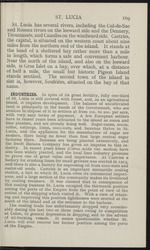 |
“...aipaous to dispose of it to settlers at from 10s. to 20s. per acre,
with very easy terms of payment. A few European settlers
have in recent years been attracted to the island as cocoa and
lime planters, and are already doing well. Sugar-canes, cocoa,
coffee, nutmegs, limes, coco-nuts, and bananas thrive in St.
Lucia, and the appliances for the manufacture of sugar are
modern, there being no fewer than four large central sugar
factories there. Bananas are being planted extensively, and
the Swift Banana Company has given an impetus to this in-
dustry. In recent years limes (Citrus acida var. medico) have
also been widely planted, and the local lime industry promises
to prove one of great value and importance. At Castries a
factory for crushing limes for small growers was erected in 1913,
and there is also a factory for expressing oil from coco-nuts and
castor-oil seeds. Castries is an important mercantile coaling
station, a fact to which St. Lucia owes its commercial import-
ance, and a large...”
|
|
| 4 |
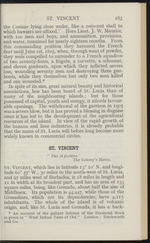 |
“...themselves lost only two men killed
and one wounded.*
In spite of its size, great natural beauty and historical
associations, less has beén heard of St. Lucia than of
many of t-he neighbouring islands; but for those
possessed of capital, youth and energy, it affords favour-
able openings. The withdrawal of the garrison in 1905
was a severe blow, but it has proved a blessing in disguise
since it has led to the development of the agricultural
resources of the island. In view of the rapid growth of
the banana and lime industries, it is already probable
that the name of St. Lucia will before long become more
widely known in commercial circles.
ST. VINCENT
Y» - “ Pax et justitia.”
The Colony’s Motto.
St. Vincent, which lies in latitude 130 10' N. and longi-
tude 60° 57' W., 30 miles to the south-west of St. Lucia,
and 97 miles west of Barbados, is 18 miles in length and
11 in width .at its broadest part, and has an area of 133
square miles, being, like Grenada, about half the size of
Middlesex. Its...”
|
|
| 5 |
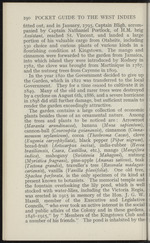 |
“...in 1822 was transferred to the local :
Government. They for a time ceased to cultivate it in ]
1849. Many of the old and rarer trees were destroyed 1 ]
by a cyclone on August 6th, 1886, arid a severe hurricane 11
in 1898 did still further damage, but sufficient remain to 1
render the garden exceedingly attractive.
The garden contains a large collection of economic 1
plants besides those of an ornamental nature. Among t
the trees and plants to be noticed are: Arrowroot I
(Maranta arundinacea), banana (Musa sapientum), il
cannon-ball (Couroupita guianensis), cinnamon (Cinna- i
momum zeylanicum), cocoa (Theobroma Cacao), clove <{
(Eugenia caryophyllata), black pepper (Piper nigrum), li
bread-fruit (Artocarpus incisa), india-rubber (Hevea 4
brasiliensis, Ceara, Castilloa, etc.), mango (Mangifera it
indica), mahogany (Swietenia Mahagoni), nutmeg 4
(Myristica fragrans), pine-apple (Ananas sativus), teak [
(Tectona grandis), traveller’s tree (Ravenala madagas- a
cariensis), vanilla (Vanilla planifolia)...”
|
|
| 6 |
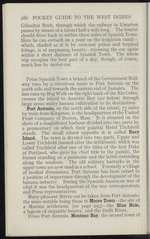 |
“...island to Annotto Bay (see below) through
large areas under banana cultivation to its destination.
Port Antonio, on the north side of the island, 75 miles
by train from Kingston, is the headquarters of the United
Fruit Company of Boston, Mass. It is situated on the
shore of a magnificent harbour divided into two parts by
a promontory on which their palatial Hotel Titchfield
stands. The small island opposite it is called Navy
Tslanfl. The town is divided into two parts, Upper and
Lower Titchfield (named after the settlement, which was
called Titchfield after one of the titles of the first Duke
of Portland, who gave his chief title to the parish), the
former standing on a peninsula and the latter extending
along the seashore. The old military barracks in the
upper town are now used as a school. Formerly a village
of modest dimensions, Port Antonio has been raised to
a position of importance through the development of the
banana industry. During the Spanish-American war of
1898 it was the...”
|
|
| 7 |
 |
“...enjoyable expedition can be made over
Mount Diablo (10 miles) to Moneague, whence a drive
may be taken through the famous Fern Gully to Ocho
Rios and the Roaring River Falls. The road over Mount
Diablo, or Diavolo, affords superb views of the Blue
Mountains. Fern Gully is a natural gorge of surpassing
beauty, with steep sides covered with ferns, through
which a winding road runs towards Ocho Rios. Sir
Harry Johnston described the gully, which he was largely
instrumental in saving from vandal banana growers, in
the following terms, to the writer: “ It is an amazing
botanical exhibit, with about twenty-five different species
of ferns, tree-ferns here and there at the top, ferns with
immense fronds, filmy creeping ferns, ferns with fronds...”
|
|
| 8 |
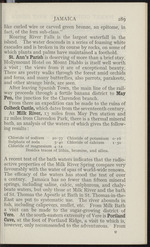 |
“...and is broken in its course by rocks, on some of
which plants and palms have maintained a foothold.
St. Ann’s Parish is deserving of more than a brief stay.
Hollymount Hotel on Mount Diablo is itself well worth
a visit; the views from it are of exceptional beauty.
There are pretty walks through the forest amid orchids
and ferns, and many butterflies, also parrots, parakeets,
and other strange birds, are seen.
After leaving Spanish Town, the main line of the rail-
way proceeds through a fertile banana district to May
Pen, the junction for the Clarendon branch.
From there an expedition can be made to the ruins of
Colbeck Castle, which dates from the seventeenth century.
At Milk River, 13 miles from May Pen station and
12 miles from Clarendon Park, there is a thermal mineral
bath, an analysis of the waters of which gives the follow-
ing results:
Chloride of sodium 20-77 Chloride of potassium 0-16
Sulphate of soda 3 • 40 Chloride of calcium 1 ■ 50
Chloride of magnesium 4-12
Besides traces of...”
|
|
| 9 |
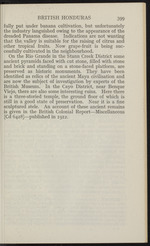 |
“...BRITISH HONDURAS
399
fully put under banana cultivation, but unfortunately
the industry languished owing to the appearance of the
dreaded Panama disease. Indications are not wanting
that the valley is suitable for the raising of citrus and
other tropical fruits. Now grape-fruit is being suc-
cessfully cultivated in the neighbourhood.
On the Rio Grande in the Stann Creek District some
ancient pyramids faced with cut stone, filled with stone
and brick and standing on a stone-faced platform, are
preserved as historic monuments. They have been
identified as relics of the ancient Maya civilisation and
are now the subject of investigation by experts of the
British Museum. In the Cayo District, near Benque
Viejo, there are also some interesting ruins. Here there
is a three-storied temple, the ground floor of which is
still in a good state of preservation. Near it is a fine
sculptured stele. An account of these ancient remains
is given in the British Colonial Report—Miscellaneous
[Cd 6428]—published...”
|
|
| 10 |
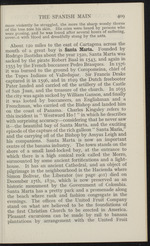 |
“...and the carrying off of the Bishop by Amyas Leigh and
his companions. Santa Marta is now an important
centre of the banana industry. The town stands on the
shore of a small land-locked bay, at the entrance to
which there is a high conical rock called the Morro,
surmounted by some ancient fortifications and a light-
house. It has an ancient Cathedral, and an object of
pilgrimage in the neighbourhood is the Hacienda where
Simon Bolivar, the Liberator _ (see page 401) died on
December 17th, 1830, which is now preserved as an
historic monument by the Government of Colombia.
Santa Marta has a pretty park and a promenade along
the beach where rank and fashion congregate in the
evenings. The offices of the United Fruit Company
stand on what are believed to be the foundations of
the first Christian Church to be erected in America.
Pleasant excursions can be made by rail to banana
plantations by arrangement with the United Fruit...”
|
|
| 11 |
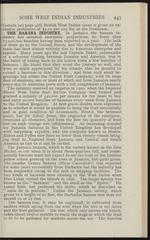 |
“...England from Jamaica and Central and South
America as fast as it can be carried.
The Jamaica banana, which is the variety known as the Gros
Michel, is cut when it is about three-quarters full, and conse-
quently tourists must not expect to see the fruit of the familiar
yellow colour growing on the trees in Jamaica, but quite green.
The smaller Canary banana [Musa Cavendishii) was exported
for some years successfully from Barbados but the industry has
been suspended owing to the lack of shipping facilities. The
two kinds of bananas were existing in the West Indies when
Père Labat visited the islands in 1696. The larger species was
known as the “ bananier ” and the small as the “ figuier.” He
tasted both, but preferred the latter, which he described as
" amie de la poitrine.” Unlike the Jamaica variety, which
grows to a height of 20 feet, the Barbados banana-tree does not
exceed 10 or 12 feet.
The banana-tree, it may be explained, is cultivated from
suckers which spring from the root when the...”
|
|
